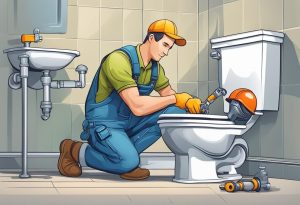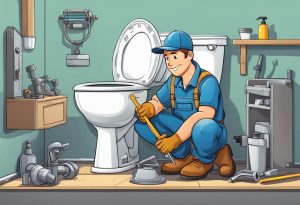Toilet repair tips are crucial for every homeowner who wants to maintain a comfortable and hygienic bathroom. A fully functioning toilet is essential for daily living, yet it can face various issues such as clogs, leaks, and internal tank malfunctions. Quick action based on effective toilet repair tips can prevent these problems from escalating, conserve water, and promote a healthier living environment. By taking the time to learn about the basic components of a toilet and the common issues that may arise, homeowners can easily spot early signs of malfunction. With the right toilet repair tips, you can confidently determine the best course of action to tackle these challenges. Knowing when to seek professional help is also vital for ensuring your toilet operates optimally and avoiding costly repairs down the line.
Diagnosing Toilet Issues
Spotting Common Problems
Homeowners often face typical toilet issues that need attention. Recognizing these problems is crucial for finding the right solutions. Here are some frequent issues:
- Clogged toilet: This occurs when a blockage forms in the drain, preventing waste and water from moving through properly. It may cause overflow or incomplete flushing.
- Running toilet: When water continuously flows from the tank into the bowl, it wastes water and could increase utility bills.
- Leaks: Water can escape around the base of the toilet, from the tank, or at the joints between the tank and bowl.
Each issue calls for a specific method to diagnose and resolve it.
Tools for Spotting Issues
To effectively tackle toilet problems, homeowners should keep some essential tools nearby. These tools assist in diagnosing and resolving common issues:
- Plunger: An effective tool for clearing clogs in the toilet’s drainpipe, making it useful for tackling blockages.
- Toilet auger: Known as a closet auger, this tool can delve deeper into the drainpipe than a plunger, removing more persistent clogs.
- Adjustable wrench: Ideal for tightening or loosening nuts and bolts that secure the connections between the tank and bowl, as well as for stopping leaks.
- Screwdriver: Useful for adjusting the toilet’s internal parts, such as the flapper or fill valve, when needed.
By using these tools, homeowners can effectively diagnose and address various toilet issues. Observing carefully and employing these tools can lead to a well-functioning bathroom.
Unclogging Techniques
Plunger Use and Effectiveness
A plunger is often the first tool to grab when dealing with a blocked toilet. To use it properly, ensure there is enough water in the bowl to cover the rubber end of the plunger. Then push the plunger into the toilet and pull it back out quickly. This motion creates suction and pressure that can help remove the blockage. It is advisable to have towels on hand to clean up any splashes. A plunger with a rubber flange tends to work better as it forms a tighter seal around the drain.
Alternative Methods for Stubborn Clogs
- Hot Water and Dish Soap: Pouring hot water (not boiling) along with some dish soap can help. The heat softens the clog, while the soap allows for a smoother flush.
- Toilet Auger or Snake: This flexible tool, also known as a plumbing snake, features a rotating head that can reach deep into the pipe system. It is effective in breaking up or pulling out tough blockages.
- Homemade Remedies: Using common household items like baking soda and vinegar can produce a reaction that helps to break down clogs. Mixing these together can create bubbles that lift away debris.
These techniques can assist in clearing a blocked toilet.
Toilet Tank Components and Maintenance
Maintaining the toilet tank is crucial for ensuring its efficient operation. The tank contains various parts that work together to manage water flow and facilitate flushing. Regular checks and adjustments can prevent issues and enhance the toilet’s longevity.
Adjusting the Flush Mechanism
Proper adjustment of the flush mechanism is necessary for effective flushing. Key components include the flapper, float, chain, and lever.
- Flush Valve: Begin by inspecting the flush valve, which governs water movement from the tank to the bowl during a flush.
- Flapper: Look for signs of wear on the flapper.
- Float: Adjusting its height impacts the water level within the tank, which, in turn, affects flushing strength.
- Chain: Check the chain linking the flush handle and the flapper. The chain should be tight enough to function properly but not overly restricted.
- Lever: The lever must move easily when pushed, allowing for smooth operation of the flushing cycle.
Replacing Faulty Valves
Malfunctioning valves in the toilet tank can result in issues such as continuous running water, overflow, or weak flushing. The primary valves to monitor are the fill valve and the flush valve. Below are steps for replacing each:
Fill Valve:
- Turn off the water supply and drain the tank.
- Disconnect the water supply tube.
- Remove the old fill valve and install a new one.
- Reconnect the water supply tube and restore the water supply.
Flush Valve:
- Turn off the water supply and take off the tank lid.
- Disconnect the flapper chain from the flush handle.
- Unscrew the locknut beneath the tank to detach the old flush valve.
- Install the new flush valve, ensuring proper placement of the gasket and locknut.
- Attach a new flapper, reconnect the chain, and test the operation of the flushing mechanism.
Routine maintenance of toilet tank components can save time and costs by avoiding more severe plumbing problems. Regularly inspecting and adjusting the flush and fill valves promotes a fully functional toilet system.
Repairing Toilet Seals and Joints
Toilet seals and joints are vital for proper operation and hygiene. This section discusses how to fix leaks at the toilet base and replace wax rings.
Fixing Leaks at the Toilet Base
Leaking at the base of a toilet often means there is an issue with the seal or wax ring connecting the toilet to the flange. Follow these steps to repair it:
- Shut off the water supply valve. Flush the toilet to drain both the tank and bowl.
- Remove the bolt caps and unscrew the nuts on both sides of the toilet base.
- Lift the toilet carefully to expose the flange and the old wax ring.
- Clean the flange and the area around it thoroughly, removing any debris or wax remnants.
- Inspect the flange for any damage, such as cracks.
- Lower the toilet back into position, aligning the bolt holes with the bolts underneath.
- Tighten the nuts firmly but be cautious not to overtighten, as this might crack the toilet base.
- Reconnect the water supply and turn it on. Flush the toilet and check for any leaks at the base.
Wax Ring Replacement
The wax ring forms a crucial seal between the toilet and the flange. Over time, it can wear out, leading to leaks. To replace the wax ring, follow these steps:
- Follow the first six steps from the “Fixing Leaks at the Toilet Base” section to remove the old wax ring.
- Lower the toilet onto the new wax ring, applying gentle, even pressure to compress the wax creating a secure seal.
- Reinstall the nuts, washers, and bolt caps as outlined in steps 8 and 9 of the previous section.
By fixing leaks and replacing old wax rings, homeowners can help maintain a clean and sanitary bathroom while avoiding common toilet problems.
Professional Assistance and Services
When to Call a Professional Plumber
There are several situations when it is important to contact a qualified plumber for toilet repairs:
- Severe Clogs: A significant blockage can lead to toilet overflows, risking damage to flooring and creating health risks. A trained plumber can quickly address the issue and restore proper function.
- Pipe Leaks: Leaking toilets cause water waste and can lead to costly damage over time.
- Continuous Running: Toilets that run endlessly waste water and increase utility costs. An experienced plumber can troubleshoot and fix the internal mechanisms to stop this waste.
It is wise to look into the reputation and qualifications of any plumbing service before engaging their help. Many firms provide free assessments and fair estimates, allowing for informed decisions.
For any significant plumbing concerns, it is best to reach out to a professional. They possess the necessary skills and knowledge to manage toilet repairs thoroughly and effectively.
Frequently Asked Questions
What are the steps to fix a toilet that keeps running?
Fixing a toilet that won’t stop running starts with identifying the source of the problem, which is often related to the flapper, fill valve, or float mechanism. Inspect the flapper for leaks, and consider replacing it if necessary. Cleaning and tweaking these parts can sometimes resolve the issue.
What are the usual costs related to toilet repairs?
The cost of repairing a toilet can differ widely based on the issue’s seriousness, what parts need replacing, and where the service is being provided. Generally, repairing a leaking toilet might cost between RM180 and RM980.
What is the best way to unclog a toilet without calling a professional?
- Using a plunger: Place the plunger over the toilet’s drain hole and press down gently. Then, pull up firmly, repeating until the blockage clears.
- Enzyme-based drain cleaner: These types of cleaners can help dissolve clogs made of organic material. Always follow the manufacturer’s directions when using such products.
- Plumbing snake: Insert a plumbing snake into the toilet drain and turn the handle to help break up and remove the clog.
How can one locate dependable plumbing services nearby?
Finding reliable plumbing services involves a few steps:
- Research online reviews: Websites and forums often have reviews from customers that highlight their experiences with local plumbers.
- Ask for recommendations: Friends, family, or neighbours may have suggestions based on their own experiences.
- Check qualifications: Make sure the plumbing service holds the appropriate licences and insurance.
- Request quotes: Contact several plumbers to get estimates and compare prices.
What are the methods and tools for accurate water leak detection?
Modern techniques for spotting water leaks include:
- Acoustic detection: This method uses sound waves to identify leaks.
- Thermal imaging: Cameras detect temperature changes that might indicate a leak.
- Real-time monitoring: Equipment that tracks water flow can pinpoint leaks when they occur.
These advanced approaches enable quicker and more precise identification of water leaks, reducing damage to properties.
How does Seven Engineering tackle water leaks in air conditioning systems?
Seven Engineering provides advanced solutions for addressing leaks in air conditioning systems. They employ methods such as acoustic detection and thermal imaging to perform regular maintenance, ensuring efficient leak detection and quick fixes. Their commitment to using cutting-edge technology highlights their expertise, translating into client satisfaction and fewer future problems.
What are the rapid detection and repair solutions offered for water leaks in pipes within walls?
Seven Engineering Group offers innovative solutions for finding and fixing concealed water leaks without causing damage. They use infrared cameras and acoustic sensors for effective pinpointing of leaks. Their strategies include modern techniques like thermal imaging and machine learning. These techniques aim to enhance water conservation efforts and promote environmental responsibility.


